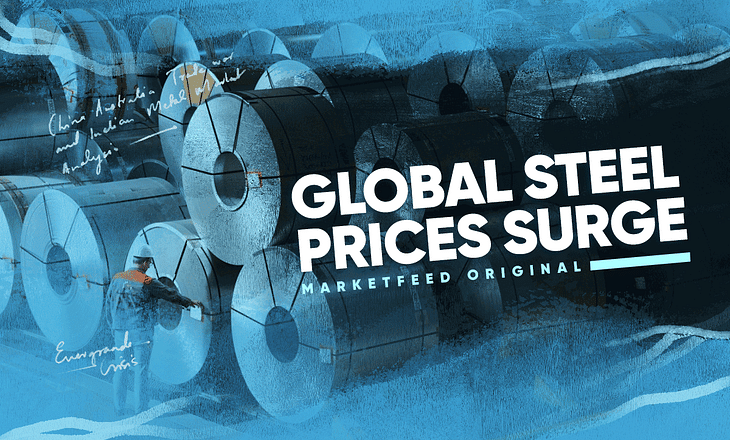Global Steel Prices Volatility, China-Australia Trade War and Indian Metal Market: Analysis

India’s metal stocks and the NIFTY METAL index have been rallying. Steel prices are soaring and iron ore prices have started to slump. Iron ore is the key raw material used to manufacture steel, yet both are following opposite trends. In December 2020, we at marketfeed discussed the soaring steel prices and how it was impacting the Indian economy. While there have been some shortfalls that are globally driving down steel prices, one crucial factor is at play, China. This piece gives an overview of the steel market and how it could impact Indian metal stocks.
China’s Economic Turbulence Impacts Global Steel Prices
The last few weeks have been tough for the Chinese economy. It first faced the Evergrande Crisis and is now facing a severe power crunch. Even though we are amidst a global energy crisis, it seems to have impacted China more than other countries. Nevertheless, there is a weird trend that exists right now in the metal market. Iron ore, a key ingredient for making steel, has its prices falling while steel prices are soaring.
The story starts with China’s trade war with Australia. China produces ~51% of the world’s steel. To make this steel, it imports 60% of the iron ore from Australia, which controls ~38% of iron ore production. The trade war started in May 2020, when China restricted barley imports from Australia, accusing it of breaching WTO rules by subsidizing barley production in China below the domestic production cost.
Australia further angered China by asking for an independent inquiry into the origin of the coronavirus. Essentially, Australia was accusing China of deliberately creating the COVID-19 pandemic. China retaliated by disrupting the imports of seafood, wood, beef, wine, and coal from Australia. Eventually, Australia restricted the supply of iron ore to China. This meant that China wouldn’t be able to produce as much steel as before. This sent steel prices on a rollercoaster globally.
To correct the supply-demand mismatch of metals in China, it has decided to release metal reserves of copper, aluminium and zinc. It shall release 170,000 tonnes of this metal into the market and more depending on how the market reacts.
The iron ore that Australia would sell to China would go to other steel manufacturing economies like India, Brazil, the US, etc. Steel, aluminium, copper, and iron ore prices have slumped in India due to fears of weak demand from China amidst an economic crisis. Nevertheless, steel demand in India is healthy, since it has managed to revamp domestic production. India is boosting its economy with multiple infrastructure projects, which ultimately require a significant amount of steel.
In Q1 FY22, India turned net exporter of finished and semi-finished steel to China for the first time in years. This could mean soaring profits for domestic steel companies in India and for their shareholders. China is currently focussing on reducing carbon emissions and is therefore importing semi-finished and finished steel from India. This would mean better profit margins for Indian steel players.
India’s Metal Markets
International steel prices are much higher than domestic prices in India. This could mean a bumper export season for domestic steel and iron companies, eventually making good profits. For the past few days, the winds in the metal markets blew in favour of Indian companies. This caused a rally in the Indian metal stocks, followed by a major correction. Between September 1, 2021, and September 16, 2021, the NIFTY Metal Index rallied by 4% or 247 points before going down amidst uncertainties surrounding the US Interest rate hike and the Evergrande crisis.
Tala Steel, SAIL, NMDC, JSW Steel, APL Apollo Tubes are some big players that can benefit from the current situation in the global markets. These companies are players in the core steel industry. They have a replenished inventory of steel products and a large consumer base, both domestic and international
The government has advised SAIL and NMDC to sell off its ‘residual iron ore fines’ from all its mines. This will not only generate supply in the market but also add to revenue (even though a small amount) of the two companies. India’s domestic steel demand is likely to remain healthy as the government has announced many infrastructure projects and some incentive schemes for them.
Currently, Indian steel companies have two marketplaces to benefit from. First, there is the global market where there is a shortage of steel supply. Second is the Indian market which is seeing fast growth in the number of infrastructure projects.
In a December 2020 issue, we discussed how India’s steel production shortage caused domestic prices to cross the international prices. India could neither export steel because of the price gap nor import it because of the import duties imposed in the country. The situation is now much better as India has plenty of steel and iron ore reserves that can be exported and meet domestic demand at the same time. Price fluctuations in the international market are not likely to impact the domestic metal market. An investor should watch out for core steel companies with high export numbers and no production bottlenecks.


Post your comment
No comments to display